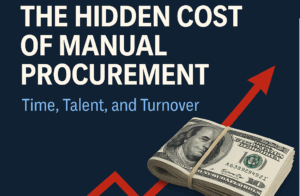Explore ways you can reduce your expedites and associated costs in just a couple of weeks.
In the ever-changing global supply chain environment, part shortages have become the “new normal,” as cliche as that term is since COVID-19. The truth is that pandemics and recessions do not necessarily create the part shortages as much as they magnify existing process gaps within material planning which resulted in shortages. Where this is most noticeable in industry today is with purchased parts, and the critical issues that arise with them can cost companies millions of dollars in lost revenue, expedites, and productivity–among other negative impacts.
Although the past couple of years make it feel as though organizations are fighting a losing battle with purchased parts, this is a defeated position to take, and the Perfect Planner Team does not believe it is accurate. There are several strategies or tips that can be utilized right now to improve the part shortages businesses are experiencing. By implementing even a couple of the recommendations below, an improvement in shortages can be seen in as little as a week.
Tip 1: Long Term Visibility Is Critical
When looking at the material planning function, one of the most glaring process gaps for many organizations is the lack of long term visibility to supply and projected inventory balances. Lead times or firm periods are often much further out into the future than what planners typically analyze and review on a daily basis. After witnessing planning in five Fortune 500 companies, it became apparent to the Perfect Planner Team that most planners managing purchase parts were only looking out two to ten business days. The modern supply chain has significantly longer lead time than it did 15 years ago with more vendors being located overseas as well as a large contingency of domestic suppliers relying on internationally sourced raw materials. In today’s world, lead times can be anywhere from 14 days all the way up to 70 plus, and the antiquated, short term planning practices of the past are no longer effective. Long term visibility is necessary to manage the supply of purchased parts. Our team’s recommendation is to alter the planning reports and/or balance sheets to extend as far into the future as the supplier lead times, and if the planning team is not including supply elements into those balances (i.e. purchase orders, releases, etc.), then they need to be added.
A good example of the consequences of not using this tip was seen at a Fortune 500 appliance manufacturer. Their planning tool only took into account on hand inventory levels, in-transit quantities, and demand. Since the average days on hand at the sites was anywhere from two to seven days, depending on the part, their visibility was approximately a week out. As a result, the appliance manufacturer had a track record of struggling with part shortages, and it became exponentially worse during the pandemic. Upon reviewing a year of their expedited shipment data and historical reports, it was concluded that over 70% of part shortages could have been seen three weeks or more in advance of the impact date if their planning teams had long term visibility and their balance sheets included supply elements.
Tip 2: Chase Past Due Purchase Orders Before They Impact You
Past due purchase orders or releases can decimate supply chains, and chasing past due deliveries is often one area planners either prefer not to prioritize, or they don’t have the bandwidth to address. However, resolving past dues without a doubt reduces shortages. From the Perfect Planner Team’s time implementing and using SAP and Oracle, we noticed certain inventory balance calculations within the system did not make much sense from a material planning perspective. For instance, most MRP/ERP systems view past due quantities as good supply elements, and they include them in the inventory balance calculations even though these orders have not arrived and are not available stock. To compound this issue, situations like these cover up shortages in system generated reports and functions (i.e. Collective Access in SAP). This process gap forces the planner to run more reports and perform analysis–or be required to have “super user” system experience to set the appropriate parameters in the system.
In our team’s opinion, this is a calculation error on behalf of the system developers who most likely never sat in the planning role. To piggy-back off of the first tip’s recommendation (and after all supply elements are included in the planning reports’ balance calculations), we advocate removing all past due deliveries from those calculations. The benefit of this action allows planners to quantify and pinpoint if and when a part shortage would occur because the order did not show up. This also reinforces the need to chase down those past dues and resolve them.
 Tip 3: Perform Root Cause Analysis to Stop a Revolving Door
Tip 3: Perform Root Cause Analysis to Stop a Revolving Door
Understanding why a shortage occurred–and more specifically what the reasons were behind the “why”–is pivotal to keep a shortage from happening again. Similar to chasing past due orders (one root cause reason), planners often do not have the desire or the time to devote to root cause analysis, mainly due to the lengthy process required by running additional reports and navigating through multiple screens essentially looking for a “needle in a haystack.” However, the Perfect Planner Team would submit that this is definitely a value added exercise in material planning, and it is backed by multiple studies.
One of these studies came from a Fortune 100 diversified manufacturing and technology company. After reviewing 18 months worth of part shortages and expedite data, the research and analysis concluded that upwards of 50% of impacted part numbers had already experienced a shortage and/or expedite event within the previous six months. These were recurring issues, and a prior shortage event’s “quick fix” or perceived resolution did not address the actual underlying reason(s) because the boomerang came back! Our recommendation would be to start with the obvious and more likely root causes, such as past due purchase orders, scrap or inventory adjustment events, and demand variances. Although there could be dozens of root cause reasons, becoming efficient and proficient with a few, and then expanding to others, is an effective path.
Tip 4: Ensure Safety Stock is Adequate
From decades of industry learnings the Perfect Planner Team has cultivated in inventory management and material planning, we recognize that not much confounds planners and supply chain leaders more than safety stock. It is a critical piece to the inventory protection model, and reviewing it is frequently not prioritized to the level it needs to be within a planning team’s responsibilities. The consensus across industries is that companies feel they have too much of what they don’t need and not enough of what they do. For the “not enough of what they do” portion of that feeling, part shortages are usually the outcome.
A Fortune 500 automotive manufacturer recognized the importance of implementing a new dynamic safety stock formula as well as recalculating and entering the results into the system every month. With the new safety stock levels identified, an analysis exercise was conducted on previous shortage situations. The question was simple: “If the safety stocks would have been set to the new formula’s recommendations, how many shortages would have been avoided due to the additional inventory protection?” Expectedly, the data showed that nearly 30% of the shortages would have been prevented.
Our recommendation is to find and implement a dynamic safety stock formula while adding periodic safety stock updates to the standard work of the planning teams. Although there are many safety stock formula options and services, our team wrote another article on this topic, and it includes an industry-proven safety stock formula that can be used and modified for an organization’s needs. The article can be found here.

Tip 5: Know When to Seek Help
Knowing when to ask for help and escalating issues is often a lifelong journey. The Perfect Planner Team realizes this, but we would assert that resolution to a problem sometimes requires the intervention of others. If tips one through four have not resolved a planning issue, or if there is something keeping a planner or supply chain leader from utilizing any of those recommendations, then it is time to request support. This can be found internally within a company, such as a manager, process expert, or purchasing/procurement leader, or it can be located from an external source, such as a consultant or solution service provider.
Our team offers a free consultation service, and our passion is to help companies bridge the process knowledge gap, resolve complex operational issues, improve the effectiveness of processes, and create efficiencies through targeted automation solutions. This is especially true for material planning. If you would like to connect with us on this article or any other topic, send us an email at info@perfectplanner.io or give us a call. You can also follow us on LinkedIn.
Author: Thomas Beil
Publication Date: March 11, 2022
© Copyright 2023 Perfect Planner LLC. All rights reserved.






